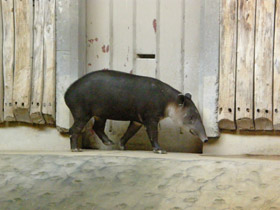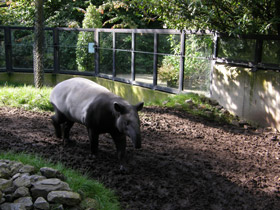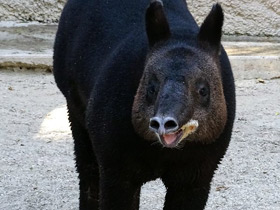Genus Tapirs
Tapirs (/ˈteɪpər, ˈteɪpɪər, təˈpɪər/ TAY-pər, TAY-peer, tə-PEER) are large, herbivorous mammals belonging to the family Tapiridae. They are similar in shape to a pig, with a short, prehensile nose trunk. Tapirs inhabit jungle and forest regions of South and Central America and Southeast Asia. They are one of three extant branches of Perissodactyla (odd-toed ungulates), alongside equines and rhinoceroses. Only a single genus, Tapirus, is currently extant. Tapirs migrated into South America during the Pleistocene epoch from North America after the formation of the Isthmus of Panama as part of the Great American Interchange. Tapirs were formerly present across North America, but became extinct in the region at the end of the Late Pleistocene, around 12,000 years ago.
Species
There are four widely recognized extant species of tapir, all in the genus Tapirus of the family Tapiridae. They are the South American tapir, the Malayan tapir, Baird's tapir, and the mountain tapir. In 2013, a group of researchers said they had identified a fifth species of tapir, the kabomani tapir. However, the existence of the kabomani tapir as a distinct species has been widely disputed, and recent genetic evidence further suggests that it actually is part of the species South American tapir.
- Baird's tapir, also called the Central American tapir (Tapirus bairdii (Gill, 1865) - Mexico, Central America and northwestern South America.
- South American tapir, also called the Brazilian tapir or lowland tapir (Tapirus terrestris (Linnaeus, 1758) - Venezuela, Colombia, and the Guianas in the north to Brazil, Argentina, and Paraguay in the south, to Bolivia, Peru, and Ecuador in the West.
- Mountain tapir, also called the woolly tapir (Tapirus pinchaque (Roulin, 1829) - Eastern and Central Cordilleras mountains in Colombia, Ecuador, and the far north of Peru.
- Malayan tapir, also called the Asian tapir, Oriental tapir or Indian tapir (Tapirus indicus (Desmarest, 1819) - Indonesia, Malaysia, Myanmar, and Thailand.
The four species are all classified on the IUCN Red List as Endangered or Vulnerable. The tapirs have a number of extinct relatives in the superfamily Tapiroidea. The closest extant relatives of the tapirs are the other odd-toed ungulates, which include horses, wild asses, zebras and rhinoceroses.
During the Late Pleistocene, several other species inhabited North America, including Tapirus veroensis, native to the southern and eastern United States (with its northernmost records being New York State), and Tapirus merriami and Tapirus californicus, native to Western North America. These became extinct during the Quaternary extinction event around 12,000 years ago, along with most of the other large mammals of the Americas, co-inciding with the first arrival of humans to the continent. Tapirus augustus (formerly placed in Megatapirus), native to Southeast and East Asia, substantially larger than the Malayan tapir, also became extinct at some point during the Late Pleistocene.
Habitat area and appearance
Tapiridae are a family of perissodactyl mammals of the suborder Ceratomorpha, with only one extant genus, Tapirus. Their closest living relatives are the rhinoceroses.
Tapirids are probably the oldest and most primitive of the non-parasitic ungulates. The name of these animals means "fat" in the language of a Brazilian tribe and they got their name from their thick skin. Tapirids are found in South America and Southeast Asia, where they live in swamp forests and thickets along the banks of rivers and lakes. The 4 modern species are remnants of a once immense group that spread throughout the northern hemisphere. The most striking feature of their structure is a small, elongated, mobile proboscis, consisting of a jointed nose and upper lip, used to pick leaves or young shoots. Tapirids have four toes on the front legs and three on the hind legs, with each toe ending in a small hoof. This limb structure helps the animal to move over soft, swampy ground. The tapir tail is short and stubby.
Lifestyle
These ancient animals are very mobile and can jump, crawl under fallen trees and often sit on their backs, which is not characteristic of other ungulates. They are excellent swimmers and divers, can stay under water for a surprisingly long time and always seek refuge there in case of danger. Living near rivers and lakes, tapirids spend a lot of time in the water, feeding on soft algae. In forests, tapirids feed on shrub leaves, fruits and berries. They are mainly active at night and often wait for the heat of the day lying or sitting in the water.
Social behaviour and reproduction
Tapirids live solitary lives and rarely occur in groups of more than three. Gestation is long, about 13 months. Tapirid young do not resemble adults and have protective colouration consisting of white longitudinal stripes and spots on a dark brown background; they spend their first days in a protected area. At six months of age, the beautiful pattern begins to fade and at one year of age the colouration becomes the same as that of adults.
Conservation
A number of conservation projects have been started around the world. The Tapir Specialist Group, a unit of the IUCN Species Survival Commission, strives to conserve biological diversity by stimulating, developing, and conducting practical programs to study, save, restore, and manage the four species of tapir and their remaining habitats in Central and South America and Southeast Asia.
The Baird's Tapir Project of Costa Rica, begun in 1994, is the longest ongoing tapir project in the world. It involves placing radio collars on tapirs in Costa Rica's Corcovado National Park to study their social systems and habitat preferences.
The Lowland Lowland Tapir Conservation Initiative is a conservation and research organization founded by Patrícia Medici, focused on tapir conservation in Brazil.
Attacks on humans
Tapirs are generally shy, but when scared they can defend themselves with their very powerful jaws. In 1998, a zookeeper in Oklahoma City was mauled and had an arm severed after opening the door to a female tapir's enclosure to push food inside (the tapir's two-month-old baby also occupied the cage at the time). In 2006, Carlos Manuel Rodriguez Echandi (who was then the Costa Rican Environmental Minister) became lost in the Corcovado National Park and was found by a search party with a "nasty bite" from a wild tapir. In 2013, a two-year-old girl suffered stomach and arm injuries after being mauled by a South American tapir in Dublin Zoo during a supervised experience in the tapir enclosure. Dublin Zoo pleaded guilty to breaching health and safety regulations and was ordered to pay €5,000 to charity. However, such examples are rare; for the most part, tapirs are likely to avoid confrontation in favour of running from predators, hiding, or, if possible, submerging themselves in nearby water until a threat is gone.
Frank Buck wrote about an attack by a tapir in 1926, which he described in his book, Bring 'Em Back Alive.



















































